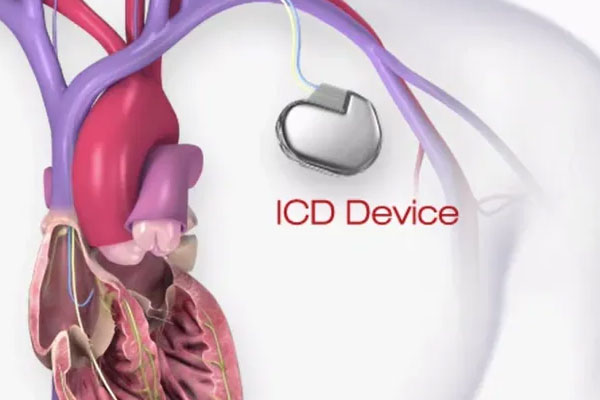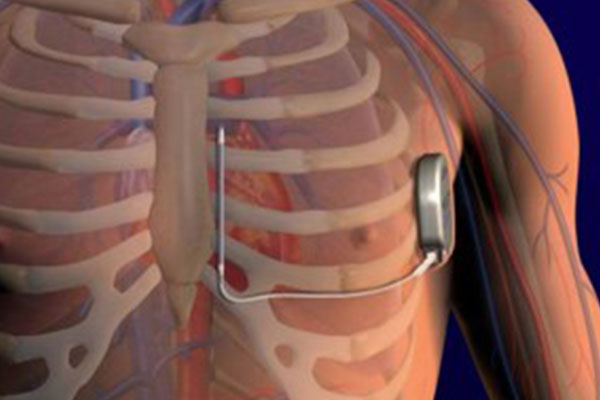A defibrillator is a device that sends electrical energy, or shock, to the heart. The aim of using a defibrillator is to treat cardiac arrest. The need for this generally arises when the patient has ventricular fibrillation or ventricular tachycardia, which are life-threatening arrhythmias that occur when contraction of the ventricles become abnormal.
Some patients will be recommended by their Cardiologists to consider having an Implantable Cardioverter Defibrillator (ICD) to prevent sudden cardiac death (SCD).
Types of Defibrillators
Transvenous implantable cardioverter defibrillator
What is an Implantable Cardioverter-Defibrillator?An implantable cardioverter defibrillator (ICD) is a small electronic device connected to the heart. It is used to continuously monitor and help regulate potentially fast and life-threatening electrical problems with the heart. It is about the size of a stopwatch and is implanted under the skin just below the collarbone. The ICD responds to irregular life-threatening heart rhythms from the lower chambers of the heart with pacing that corrects a fast rhythm and promotes a normal heartbeat, or a shock (defibrillation) that resets the heart rhythm to prevent sudden cardiac arrest. An ICD also records and stores information about your heart rhythm and therapies delivered by the ICD for your doctor to review.
Most people are unaware when the ICD is pacing the heart. But, a defibrillation shock is described by many as feeling like a "kick in the chest." The ICD can also be programmed to work as a basic pacemaker as needed. Sometimes after a shock is delivered, the heart may beat too slowly. The ICD has a "back-up" pacemaker, which can stimulate the heart to beat faster until the normal heart rhythm returns. The ICD can act as a pacemaker any time the heart rate drops below a preset rate.

How to implantable a cardiac defibrillator.
What can I expect during the procedure?
For most people undergoing an ICD implantation, it is done under conscious sedation with a light sedative and a numbing medication at the site of insertion. An incision will be made just below the collar bone to make a "pocket" for the ICD device to go into. Up to 3 leads (or wires) will be placed through the incision and into your heart's atrium or ventricle. Once the leads are in position, they are connected to the ICD. The device will be tested prior to ending the procedure by making your heart beat quickly and will receive a shock from your new ICD to stop it. If successful, the incision is closed and you return to the cardiac recovery area. This entire process takes anywhere from 45 to 60 minutes.

Subcutaneous implantable cardioverter defibrillator
The S-ICD System is the world's first ICD that provides defibrillation therapy without touching the heart. It is a completely subcutaneous defibrillator that does not require leads in the heart, leaving the vasculature untouched. It can be placed strictly by anatomical landmarks, removing the need for fluoroscopy at implant. It is an alternative to the conventional transvenous implantable cardiac defibrillator and was approved by the FDA in late 2012.
The S-ICD System is intended to provide defibrillation therapy for the treatment of life-threatening ventricular tachyarrhythmias in patients who do not have symptomatic bradycardia. It can still be an option for patients who already have a preexisting functional transvenous bipolar pacemaker.
The S-ICD provides effective defibrillation for ventricular tachyarrhythmias , significantly reduces the risk of vascular injury at the time of implant, has a low risk of systemic infection given no hardware in the venous system, preserves venous access (a high priority for some patients including those with end-stage renal disease who are on or are preparing for hemodialysis), avoids risks associated with endovascular lead extraction if future lead fracture or infection, and again requires no fluoroscopy at the time of implant.
Your electrophysiologist will able to discuss this option more in-depth with you to determine if you are a good candidate and proceed with in-office required preoperative 3-lead surface electrocardiogram screening to ensure that you are a reasonable candidate for this therapy (given the appropriateness of surface signals).
How the Subcutaneous ICD System is Implanted
Need a Doctor for Check-up?
Diagnosis, Diagnostics, and Efficient Treatment Plans All healthcare plans are accepted. Visit our qualified team of physicians today!
